Silent Era Home Page > Home Video > The Movies Begin

Reviews of silent film releases on home video.
Copyright © 1999-2025 by Carl Bennett
and the Silent Era Company.
All Rights Reserved. |
|
The
Movies Begin
(1894-1913)
|
Contents: The Barbershop (1894), Cock Fight (1894), Glenroy Bros. (Comic Boxing) (1894), Sandow (1894), Annabelle Butterfly Dance (1895) [second version], Le Débarquement du congrès de photographie à Lyon [Arrivée des Congressistes á Neuville-Sur-Sâone / Arrival of Congress Members at Neuville-Sur-Sâone] (1895), Arrivée d’un train en gare á la Ciotat [The Arrival of a Train at La Ciotat] (1895), L’Arroseur arrosé [The Sprinkler Sprinkled] (1895) [first version], Barque sortant du port [Boat Leaving the Port] (1895), Baignade en mer [Swimming in the Sea] (1895), [Childish Quarrel] [The Babies’ Quarrel] (1895), Démolition d’un mur [Demolition of a Wall] (1895), The Derby (1895), [Lion, London Zoological Gardens] (1895), Partie d'écarté [Card Party] (1895), Le repas de bébé [The Baby's Meal] (1895), A Rough Sea at Dover (1895), La sortie des ouvriers de l’usine Lumière [Leaving the Factory] (1895) [third version], Chapeaux à transformations [Transformation by Hats] (1895), Lumiere films (1895-1896) [Loading a Boiler] (no. 20), [Children Digging for Clams] (no. 45), Photographe (1895), [Arab Cortege, Geneva] (1896), Autruches [Promenade of Ostriches] (1896), Basse-cour [Poultry-Yard] (1896), Carmaux, d’fournage du coke [Carmaux: Drawing Out the Coke] (1896), Dragons traversant la Sâone à la nage [Dragoons Crossing the Sâone] (1896), Feeding the Doves (1896), [Leaving Jerusalem by Railway] (1896), Major McKinley at Home (1896), The May Irwin Kiss [The Kiss] (1896), New York, Broadway et Union Square [New York: Broadway and Union Square] (1896), Niagara, les chutes [Niagara Falls] (1896), [Policemen’s Parade, Chicago] (1896), Pont de Brooklyn [New York: Brooklyn Bridge] (1896), Serpentine Dance (circa 1896), Pompiers à Lyon [Sortie de la pompe (Lyon) / A Fire Run (Lyon)] (1896), Bataille de neige [Snowball Fight] (1897), Dewar’s Scotch Whiskey [Dewar’s — It’s Scotch] (1897), Girls Swinging (1897), The Miller and the Sweep (1897) [first or second version], Seminary Girls (1897), Come Along Do! (1898) [incomplete], Shooting Captured Insurgents (1898), The Kiss in the Tunnel (1899), The Kiss in the Tunnel (1899), As Seen Through the Telescope (1900), The Biter Bit (1900), Course de taureaux [Spanish Bullfight] (1900), Execution of a Spy (1900), Explosion of a Motor Car (1900), Grandma’s Reading Glass (1900), How It Feels to Be Run Over (1900), Ladies’ Skirts Nailed to a Fence (circa 1900), Let Me Dream Again (1900), Rough Sea (circa 1900), Another Job for the Undertaker (1901), Attack on a China Mission — Bluejackets to the Rescue (1901), A Big Swallow (1901), The Countryman and the Cinematograph [The Countryman’s First Sight of the Animated Pictures] (1901), Execution of Czolgosz, with Panorama of Auburn Prison (1901), Fire! (1901), Histoire d’un Crime [History of a Crime] (1901), Mary Jane’s Mishap; or, Don’t Fool with Paraffin (1901), Pack Train on the Chilkoot Pass (1901), Par le trou de serrue [Peeping Tom] (1901), Reve et réalité [Dream and Reality] (1901), Stop Thief! (1901), Ali Baba et les quarante voleurs [Ali Baba and the Forty Thieves] (1902) [incomplete 1905 rerelease version], The Burlesque Suicide (1902) [first or second version], The Draped Model (1902), Interrupted Bathers (1902), Le Voyage dans la lune [A Trip to the Moon] (1902), A Chess Dispute (1903), Daring Daylight Burglary (1903), Desperate Poaching Affray (1903), Discovery of Bodies (1903), Electrocuting an Elephant (1903), Extraordinary Cab Accident (1903), From Show Girl to Burlesque Queen (1903), The Gay Shoe Clerk (1903), The Georgetown Loop (Colorado) (1903), The Great Train Robbery (1903), The Sick Kitten (1903), Sky Scrapers of New York, from the North River (1903), The Bold Bank Robbery (1904), Buy Your Own Cherries (1904), A Fire in a Burlesque Theatre (1904), An Interesting Story (1904), Le Merveilleux eventail vivant [The Wonderful Living Fan] (1904), The Other Side of the Hedge (1904), Le Roi du maquillage [The Untamable Whiskers] (1904), Le sirène [The Mermaid] (1904), Sorcellerie culinaire [The Cook in Trouble] (1904), Le thaumaturge Chinoise [Tchin-Chao, the Chinese Conjurer] (1904), The Troubles of a Manager of a Burlesque Show (1904), Le Voyage à travers l’impossible [An Impossible Voyage] (1904), Airy Fairy Lillian Tries on Her New Corsets (1905), Les Cartes vivantes [The Living Playing Cards] (1905), La chaise à porteurs enchantée [The Enchanted Sedan Chair] (1905), Le Diable noir [The Black Imp] (1905), I.B. Dam and the Whole Dam Family (1905), Rescued by Rover (1905), Tom, Tom, the Piper’s Son (1905), Le tripot clandestin [The Scheming Gamblers Paradise] (1905), Les Affiches en goguette [The Hilarious Posters] (1906), Aladin ou la lampe merveilleuse [Aladdin; or, The Marvelous Lamp] (1906), L’alchimiste Parafaragamus ou la Cornue infernale [The Mysterious Retort] (1906), Dream of a Rarebit Fiend (1906), The (?) Motorist (1906), La révolution en Russie [Revolution in Odessa] (1906), San Francisco: Aftermath of Earthquake (1906), A Visit to Peek Frean & Co. (1906) [extracts], Le cheval emballé [The Runaway Horse] (1907), La Colle universelle [Good Glue Sticks] (1907), L’Eclipse du soleil en pleine lune [The Eclipse: The Courtship of the Sun and the Moon] (1907), La course des sergents de ville [The Policemen’s Little Run] (1907), Le scarab’ee d’or [The Golden Beetle] (1907), That Fatal Sneeze (1907), Les chiens et ses services [The Dog and His Various Merits] (1908), [Magic Bricks] (1908), Moscou sous la neige [Moscow Clad in Snow] (1908), La photographie électrique à distance [Long Distance Wireless Photography] (1908), The Physician of the Castle [A Narrow Escape] (1908) [incomplete], Nerone [Nero; or, The Fall of Rome] (1909), [Aeroplane Flight and Wreck (piloted by M. Cody)] (1910), A Day in the Life of a Coal Miner (1910), Winsor McCay, the Famous Cartoonist of the N.Y. Herald and His Moving Comics (1911), The Girl and Her Trust (1912), The Making of an American Citizen (1912), Max reprend sa liberté [Troubles of a Grasswidower] (1912), Onésime horloger [Onésime, Clock-Maker] (1912), and Bangville Police (1913).
Originally released by Kino International in 1994 as a five-videocassette collection, The Movies Begin is a self-encapsulated history lesson for film buffs. The collection is an excellent overview of the first 20 years or so of motion picture production in the United States and Europe. Well represented in the set are the early experimental films of America, France and England, which date from 1894 through the turn of the century. Thus, many of the more than 130 films in the set then last from about 20 seconds to several minutes. The films of the latter part of the first decade of the 20th century generally last approximately 10 minutes. Longer films are generally contained in volume five. Much of the content of volumes one and five were condensed by video producer David Shepard onto one DVD entitled Landmarks of Early Film, which was published in 1998.
The Movies Begin as a whole covers a lot historical ground but, with more than 130 films represented here, the collection makes a satisfying retrospective of what are three distinct phases in the evolution of filmmaking. It is interesting to see a number of films in this collection by different filmmakers on the same subject or idea. Whether the remakes are straight copies of an earlier film or an elaboration of an earlier idea, the viewer will have a basic understanding of the mindset of filmmakers, audiences, and the development of film as an artform after having absorbed this collection.
— Carl Bennett
|
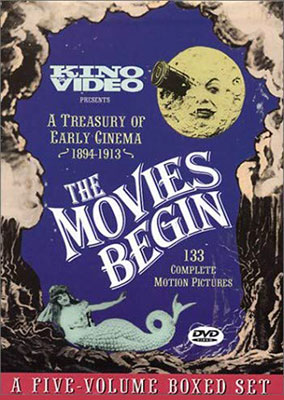 Kino on Video Kino on Video
2002 DVD edition
The Movies Begin (1894-1913), black & white and color-tinted black & white, 414 minutes total, not rated, including The Barbershop (1894), black & white, 1 minute, not rated, Cock Fight (1894), black & white, 1 minute, not rated, Glenroy Bros. (Comic Boxing) (1894), black & white, 28 seconds, not rated, Sandow (1894), black & white, 23 seconds, not rated, Annabelle Butterfly Dance (1895) [second version], color-tinted black & white, 15 seconds, not rated, Le débarquement du congrès de photographie à Lyon [Arrivée des Congressistes á Neuville-Sur-Sâone / Arrival of Congress Members at Neuville-Sur-Sâone] (1895), black & white, 1 minute, not rated, Arrivée d’un train en gare á la Ciotat [The Arrival of a Train at La Ciotat] (1895), black & white, 1 minute, not rated, L’Arroseur arrosé [The Sprinkler Sprinkled] (1895) [first version], black & white, 1 minute, not rated, Barque sortant du port [Boat Leaving the Port] (1895), black & white, 1 minute, not rated, Baignade en mer [Swimming in the Sea] (1895), black & white, 1 minute, not rated, [Childish Quarrel] [The Babies’ Quarrel] (1895), black & white, 1 minute, not rated, Démolition d’un mur [Demolition of a Wall] (1895), black & white, 1 minute, not rated, The Derby (1895), black & white, 1 minute, not rated, [Lion, London Zoological Gardens] (1895), black & white, 1 minute, not rated, Partie d'écarté [Card Party] (1895), black & white, 1 minute, not rated, Le repas de bébé [The Baby's Meal] (1895), black & white, 1 minute, not rated, A Rough Sea at Dover (1895), black & white, 30 seconds, not rated, La sortie des ouvriers de l'usine Lumière [Leaving the Factory] (1895) [third version], black & white, 1 minute, not rated, Chapeaux à transformations [Transformation by Hats] (1895), black & white, 1 minute, not rated, [Loading a Boiler] (no. 20), black & white, 1 minute, not rated, [Children Digging for Clams] (no. 45), black & white, 1 minute, not rated, Photographe (1895), black & white, 1 minute, not rated, [Arab Cortege, Geneva] (1896), black & white, 1 minute, not rated, Autruches [Promenade of Ostriches] (1896), black & white, 1 minute, not rated, Basse-cour [Poultry-Yard] (1896), black & white, 1 minute, not rated, Carmaux, défournage du coke [Carmaux: Drawing Out the Coke] (1896), black & white, 1 minute, not rated, Dragons traversant la Sâone à la nage [Dragoons Crossing the Sâone] (1896), black & white, 1 minute, not rated, Feeding the Doves (1896), black & white, 24 seconds, not rated, [Leaving Jerusalem by Railway] (1896), black & white, 1 minute, not rated, Major McKinley at Home (1896), black & white, 1 minute, not rated, The May Irwin Kiss [The Kiss] (1896), black & white, 20 seconds, not rated, New York, Broadway et Union Square [New York: Broadway and Union Square] (1896), black & white, 1 minute, not rated, Niagara, les chutes [Niagara Falls] (1896), black & white, 1 minute, not rated, [Policemen’s Parade, Chicago] (1896), black & white, 1 minute, not rated, Pont de Brooklyn [New York: Brooklyn Bridge] (1896), black & white, 1 minute, not rated, Serpentine Dance (circa 1896), color-tinted black & white, 16 seconds, not rated, Pompiers à Lyon [Sortie de la pompe (Lyon) / A Fire Run (Lyon)] (1896), black & white, 1 minute, not rated, Bataille de neige [Snowball Fight] (1897), black & white, 1 minute, not rated, Dewar’s Scotch Whiskey [Dewar’s — It’s Scotch] (1897), black & white, 1 minute, not rated, Girls Swinging (1897), black & white, ? minutes, not rated, The Miller and the Sweep (1897) [first or second version], black & white, 1 minute, not rated, Seminary Girls (1897), black & white, 1 minute, not rated, Come Along Do! (1898) [incomplete], black & white, 1 minute, not rated, Shooting Captured Insurgents (1898), black & white, ? minutes, not rated, The Kiss in the Tunnel (1899), black & white, 1 minute, not rated, The Kiss in the Tunnel (1899), black & white, 1 minute, not rated, As Seen Through the Telescope (1900), black & white, 1 minute, not rated, The Biter Bit (1900), black & white, 1 minute, not rated, Course de taureaux [Spanish Bullfight] (1900), black & white, 1 minute, not rated, Execution of a Spy (1900), black & white, ? minutes, not rated, Explosion of a Motor Car (1900), black & white, 1 minute, not rated, Grandma’s Reading Glass (1900), black & white, 1 minute, not rated, How It Feels to Be Run Over (1900), black & white, 1 minute, not rated, Ladies’ Skirts Nailed to a Fence (circa 1900), black & white, 1 minute, not rated, Let Me Dream Again (1900), black & white, 1 minute, not rated, Rough Sea (circa 1900), black & white, 1 minute, not rated, Another Job for the Undertaker (1901), black & white, ? minutes, not rated, Attack on a China Mission — Bluejackets to the Rescue (1901), black & white, 1 minute, not rated, A Big Swallow (1901), black & white, 1 minute, not rated, The Countryman and the Cinematograph [The Countryman’s First Sight of the Animated Pictures] (1901), black & white, 25 seconds, not rated, Execution of Czolgosz, with Panorama of Auburn Prison (1901), black & white, ? minutes, not rated, Fire! (1901), black & white, 5 minutes, not rated, Histoire d’un Crime [History of a Crime] (1901), black & white, 5 minutes, not rated, Mary Jane’s Mishap; or, Don’t Fool with Paraffin (1901), black & white, 4 minutes, not rated, Pack Train on the Chilkoot Pass (1901), black & white, 1 minute, not rated, Par le trou de serrue [Peeping Tom] (1901), black & white, 2 minutes, not rated, Reve et réalité [Dream and Reality] (1901), black & white, 1 minute, not rated, Stop Thief! (1901), black & white, 2 minutes, not rated, Ali Baba et les quarante voleurs [Ali Baba and the Forty Thieves] (1902) [incomplete 1905 rerelease version], black & white, 8 minutes, not rated, The Burlesque Suicide (1902) [first or second version], black & white, ? minutes, not rated, The Draped Model (1902), black & white, ? minutes, not rated, Interrupted Bathers (1902), black & white, ? minutes, not rated, Le Voyage dans la lune [A Trip to the Moon] (1902), black & white, 12 minutes, not rated, A Chess Dispute (1903), black & white, 1 minute, not rated, Daring Daylight Burglary (1903), black & white, 4 minutes, not rated, Desperate Poaching Affray (1903), black & white, 3 minutes, not rated, Discovery of Bodies (1903), black & white, ? minutes, not rated, Electrocuting an Elephant (1903), black & white, ? minutes, not rated, Extraordinary Cab Accident (1903), black & white, 1 minute, not rated, From Show Girl to Burlesque Queen (1903), black & white, 1 minute, not rated, The Gay Shoe Clerk (1903), black & white, 1 minute, not rated, The Georgetown Loop (Colorado) (1903), black & white, 3 minutes, not rated, The Great Train Robbery (1903), black & white and color-tinted black & white, 10 minutes, not rated, The Sick Kitten (1903), black & white, 1 minute, not rated, Sky Scrapers of New York, from the North River (1903), black & white, 3 minutes, not rated, The Bold Bank Robbery (1904), black & white, ? minutes, not rated, Buy Your Own Cherries (1904), black & white, 4 minutes, not rated, A Fire in a Burlesque Theatre (1904), black & white, 1 minute, not rated, An Interesting Story (1904), black & white, 4 minutes, not rated, Le Merveilleux eventail vivant [The Wonderful Living Fan] (1904), black & white, 3 minutes, not rated, The Other Side of the Hedge (1904), black & white, 2 minutes, not rated, Le roi du maquillage [The Untamable Whiskers] (1904), black & white, 3 minutes, not rated, Le sirène [The Mermaid] (1904), black & white, 4 minutes, not rated, Sorcellerie culinaire [The Cook in Trouble] (1904), black & white, 4 minutes, not rated, Le Thaumaturge Chinoise [Tchin-Chao, the Chinese Conjurer] (1904), black & white, 3 minutes, not rated, The Troubles of a Manager of a Burlesque Show (1904), black & white, 2 minutes, not rated, Le Voyage à travers l’impossible [An Impossible Voyage] (1904), color-tinted black & white, 21 minutes, not rated, Airy Fairy Lillian Tries on Her New Corsets (1905), black & white, 1 minute, not rated, Les Cartes vivantes [The Living Playing Cards] (1905), black & white, ? minutes, not rated, La Chaise à porteurs enchantée [The Enchanted Sedan Chair] (1905), black & white, 3 minutes, not rated, Le Diable noir [The Black Imp] (1905), black & white, 4 minutes, not rated, I.B. Dam and the Whole Dam Family (1905), black & white, 2 minutes, not rated, Rescued by Rover (1905), black & white, 6 minutes, not rated, Tom, Tom, the Piper’s Son (1905), black & white, ? minutes, not rated, Le tripot clandestin [The Scheming Gamblers Paradise] (1905), black & white, 3 minutes, not rated, Les Affiches en goguette [The Hilarious Posters] (1906), black & white, 3 minutes, not rated, Aladin ou la lampe merveilleuse [Aladdin; or, The Marvelous Lamp] (1906), black & white, 12 minutes, not rated, L’alchimiste Parafaragamus ou la Cornue infernale [The Mysterious Retort] (1906), black & white, 3 minutes, not rated, Dream of a Rarebit Fiend (1906), black & white, 5 minutes, not rated, The (?) Motorist (1906), black & white, 2 minutes, not rated, La révolution en Russie [Revolution in Odessa] (1906), black & white, 4 minutes, not rated, San Francisco: Aftermath of Earthquake (1906), black & white, 1 minute, not rated, A Visit to Peek Frean & Co. (1906) [extracts], black & white, 12 minutes, not rated, Le cheval emballé [The Runaway Horse] (1907), black & white, 7 minutes, not rated, La Colle universelle [Good Glue Sticks] (1907), black & white, 5 minutes, not rated, L’Eclipse du soleil en pleine lune [The Eclipse: The Courtship of the Sun and the Moon] (1907), black & white, 9 minutes, not rated, La course des sergents de ville [The Policemen’s Little Run] (1907), black & white, 6 minutes, not rated, Le Scarab’ee d’or [The Golden Beetle] (1907), color-tinted black & white, 3 minutes, not rated, That Fatal Sneeze (1907), black & white, 6 minutes, not rated, Les chiens et ses services [The Dog and His Various Merits] (1908), black & white, 2 minutes, not rated, [Magic Bricks] (1908), black & white, 3 minutes, not rated, Moscou sous la neige [Moscow Clad in Snow] (1908), black & white, 7 minutes, not rated, La photographie électrique à distance [Long Distance Wireless Photography] (1908), black & white, 6 minutes, not rated, The Physician of the Castle [A Narrow Escape] (1908) [incomplete], black & white, 6 minutes, not rated, Nerone [Nero; or, The Fall of Rome] (1909), black & white, 12 minutes, not rated, [Aeroplane Flight and Wreck (piloted by M. Cody)] (1910), black & white, 4 minutes, not rated, A Day in the Life of a Coal Miner (1910), black & white, 9 minutes, not rated, Winsor McCay, the Famous Cartoonist of the N.Y. Herald and His Moving Comics (1911), black & white, 7 minutes, not rated, The Girl and Her Trust (1912), black & white, 15 minutes, not rated, The Making of an American Citizen (1912), black & white, 16 minutes, not rated, Max reprend sa liberté [Troubles of a Grasswidower] (1912), black & white, 10 minutes, not rated, Onésime horloger [Onésime, Clock-Maker] (1912), black & white, 8 minutes, not rated, and Bangville Police (1913), black & white, 8 minutes, not rated.
Kino International, K236A-E, UPC 7-38329-02362-1.
Five single-sided, single-layered, Region 0 NTSC DVD discs; 1.33:1 aspect ratio picture in full-frame and windowboxed 4:3 (720 x 480 pixels) interlaced scan image encoded in SDR MPEG-2 format at 5.5 Mbps average video bit rate (capable of progressive scan upscaling to 60 fps); Dolby Digital (AC3) 2.0 stereo sound encoded at 192 Kbps audio bit rate; English language intertitles, no subtitles; chapter stops; five standard DVD keepcases in cardboard box; $99.95.
Release date: 19 February 2002.
Country of origin: USA
Ratings (1-10): video: 8 / audio: 8 / additional content: 5 / overall: 8.
|
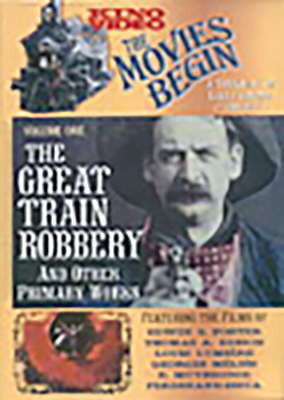 Volume One: The Great Train Robbery and Other Primary Works covers the years beginning in the 1880s through 1907, with the films presented in roughly chronological order. Much of this first disc is comprised of early films by the Edison studio, the Société Lumière and Pathé Frères, with nods to Méliès, Lubin and Biograph. This program was produced by David Shepard. Volume One: The Great Train Robbery and Other Primary Works covers the years beginning in the 1880s through 1907, with the films presented in roughly chronological order. Much of this first disc is comprised of early films by the Edison studio, the Société Lumière and Pathé Frères, with nods to Méliès, Lubin and Biograph. This program was produced by David Shepard.
Of note among the 19th-century films are Sandow (1894), The Kiss (1896), Feeding the Doves (1896), Major McKinley at Home (1897), with Autruches [Promenade of Ostriches] (1896), Chapeaux à transformations [Transformation by Hats] (1895), and Pont de Brooklyn [New York: Brooklyn Bridge] (1896), produced by Lumière.
Georges Méliès’ A Trip to the Moon (1902) is well represented here in a high-quality version, with description and clarification of the action by a French-accented narrator.
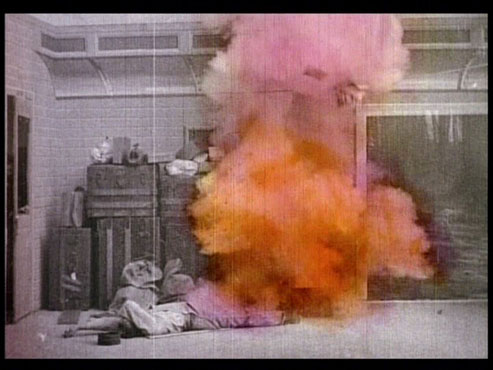
Edwin S. Porter’s pivotal short film The Great Train Robbery (1903) has also been included. This was certainly not the first realistic narrative film but it was certainly the coalescence of a series of filmmaking techniques that helped propel the motion picture industry into its next major phase of development.
It needs to be noted that the film included in this collection as The Whole Dam Family and the Dam Dog (1905) is not the Edison original, but rather the Lubin Manufacturing Company remake I.B. Dam and the Whole Dam Family (1905). This new DVD release could have presented the opportunity to correct this titling error, and we are surprised that Charles Musser did not clarify this faux pas in his notes or that Kino did not correct the mistake.
San Francisco: Aftermath of an Earthquake (1906) is a compilation of documentary shots of the devastation caused by the great earthquake of 1906. And a special attraction is Segundo de Chomon’s film Le Scarab’ee d’or [The Golden Beetle] (1907), with its hand-tinting done in the Pathé stencil color process.
The complete volume contents are: Homage to Eadweard Muybridge (197?); Edison shorts The Barbershop (1894), Cock Fight (1894), Glenroy Bros. (Comic Boxing) (1894), Sandow (1894), the second version of Annabelle Butterfly Dance (1895), The May Irwin Kiss [The Kiss] (1896), Serpentine Dance (circa 1896), Feeding the Doves (1896) and Seminary Girls (1897); Lumiere films (1895-1896) Baignade en mer [Swimming in the Sea] (1895), [Children Digging for Clams] (no. 45), [Loading a Boiler] (no. 20), Dragons traversant la Sâone à la nage [Dragoons Crossing the Sâone] (1896), Autruches [Promenade of Ostriches] (1896), [Childish Quarrel] [The Babies’ Quarrel] (1895), [Lion, London Zoological Gardens] (1895), [Photograph] (no. 118), Chapeaux à transformations [Transformation by Hats] (1895), Carmaux, défournage du coke [Carmaux: Drawing Out the Coke] (1896), Basse-cour [Poultry-Yard] (1896), [Arab Cortege, Geneva] (1896), Pont de Brooklyn [New York: Brooklyn Bridge] (1896), New York, Broadway et Union Square [New York: Broadway and Union Square] (1896), and [Policemen’s Parade, Chicago] (1896); Le voyage dans la lune [A Trip to the Moon] (1902); actualities Major McKinley at Home (1897), Pack Train on the Chilkoot Pass (1901), Sky Scrapers of New York, from the North River (1903), The Georgetown Loop (Colorado) (1903), San Francisco: Aftermath of Earthquake (1906), The Dog and His Various Merits (1908), [Moscow Clad in Snow] (1908) and [Aeroplane Flight and Wreck (piloted by M. Cody)] (1910); blue movies A Fire in a Burlesque Theatre (1904) misdated as 1908, Airy Fairy Lillian Tries on Her New Corsets (1905) misdated as 1908, From Show Girl to Burlesque Queen (1903) misdated as 1908, and The Troubles of a Manager of a Burlesque Show (1904) misdated as 1908; The Great Train Robbery (1903); Lubin’s I.B. Dam and the Whole Dam Family (1905) misidentified as Edison’s The Whole Dam Family and the Dam Dog (1905); and Le scarab’ee d’or [The Golden Beetle] (1907).
Many of the films are transferred to video from 35mm original prints (with a few apparently taken from Library of Congress paper prints). The clarity of some of the films is striking. Only the film Pack Train on the Chilkoot Pass (1901) is of questionable quality (and historic value).
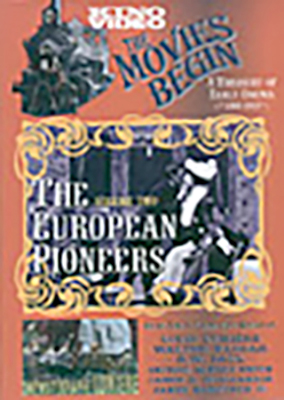 Volume Two: The European Pioneers stands as a European complement to volume one. This collection of early films held by the British Film Institute includes French and British actualities, comedies, dramas and novelties. The British films in this volume have largely been overlooked here in America, partly due to access and partly due to the (possible) overemphasis in film histories and film courses on the Edison, Biograph and Lumière companies. Viewers will have the opportunity to study several early British films (in addition to the twelve Lumière films also here) from a handful of producers. The roots of British film comedy, as bizarre as it sometimes is, can be traced to some of these films. This program was produced by Heather Stewart for the British Film Institute and has previously been available in the United Kingdom on VHS videotape, and was released on DVD by BFI in 2005. Volume Two: The European Pioneers stands as a European complement to volume one. This collection of early films held by the British Film Institute includes French and British actualities, comedies, dramas and novelties. The British films in this volume have largely been overlooked here in America, partly due to access and partly due to the (possible) overemphasis in film histories and film courses on the Edison, Biograph and Lumière companies. Viewers will have the opportunity to study several early British films (in addition to the twelve Lumière films also here) from a handful of producers. The roots of British film comedy, as bizarre as it sometimes is, can be traced to some of these films. This program was produced by Heather Stewart for the British Film Institute and has previously been available in the United Kingdom on VHS videotape, and was released on DVD by BFI in 2005.
The highlights of this volume are Démolition d’un mur [Demolition of a Wall] (1895), L’arroseur arrosé [The Sprinkler Sprinkled], Arrivée d’un Train en Gare á la Ciotat [The Arrival of a Train at La Ciotat] (1895), Rough Sea at Dover (1895) one of the earliest British films, Grandma’s Reading Glass (1900), A Big Swallow (1901), Fire! (1901), A Chess Dispute (1903), Mary Jane’s Mishap; or, Don’t Fool with Paraffin (1901) G.A. Smith’s final film before moving on to color film development, Daring Daylight Burglary (1903), Desperate Poaching Affray (1903) and An Interesting Story (1905).
It is worth noting that, while there are a few film content duplications, the Kino DVD The Lumière Brothers’ First Films makes an excellent adjunct to this collection. That volume contains 85 Lumière films dating from 1895 through 1897 and will serve to give additional insight into the work of the Lumière brothers and their worldwide network of cameramen.
The complete volume contents are: Lumiere Brothers’ La Sortie des ouvriers de l'usine Lumière [Leaving the Factory] (1895) [third version], Le Repas de bébé [The Baby's Meal] (1895), Démolition d’un mur [Demolition of a Wall] (1895), the famous L’Arroseur arrosé [The Sprinkler Sprinkled] (1895) original version, Le débarquement du congrès de photographie à Lyon [Arrivée des Congressistes á Neuville-Sur-Sâone / Arrival of Congress Members at Neuville-Sur-Sâone] (1895), Arrivée d’un Train en Gare á la Ciotat [The Arrival of a Train at La Ciotat] (1895), Partie d'écarté [Card Party] (1895), Barque sortant du port [Boat Leaving the Port] (1895), [Leaving Jerusalem by Railway] (1896), Bataille de neige [Snowball Fight] (1897), Pompiers à Lyon [Sortie de la pompe (Lyon) / A Fire Run (Lyon)] (1896), Niagara, les chutes [Niagara Falls] (1896), Course de taureaux [Spanish Bullfight] (1900); Birt Acres’ Rough Sea at Dover (1895); Robert W. Paul’s Come Along Do! (1898) incomplete, The Derby (1895), The Countryman and the Cinematograph [The Countryman’s First Sight of the Animated Pictures] (1901), A Chess Dispute (1903), Extraordinary Cab Accident (1903), Buy Your Own Cherries (1904), The (?) Motorist (1899); G.A. Smith’s The Miller and the Sweep (1897), The Kiss in the Tunnel (1899), Let Me Dream Again (1900), Grandma’s Reading Glass (1900), As Seen Through the Telescope (1900), The Sick Kitten (1903) and Mary Jane’s Mishap; or, Don’t Fool with Paraffin (1901); Sheffield Photographic Company’s Daring Daylight Burglary (1903); Haggar & Sons’ Desperate Poaching Affray (1903); Bamforth and Company’s The Kiss in the Tunnel (1899), Ladies’ Skirts Nailed to a Fence (circa 1900), The Biter Bit (1900), Rough Sea (circa 1900); Williamson’s Kinematograph Company’s Attack on a China Mission — Bluejackets to the Rescue (1900), The Big Swallow (1901?), Stop Thief! (1901), Fire! (1901) and An Interesting Story (1904).
The films have been transferred from 35mm prints from good to very good in quality. The films are all windowboxed to allow the maximum image to be seen on all televisions.
Under the ‘Select Film’ menu, from the second menu screen keep pushing the right selection button until the hidden button appears to take you to the ‘It Came from Beneath the Vault’ screen. Here you can access ten early Biograph, Edison and Lubin films: Girls Swinging (1897), Shooting Captured Insurgents (1898), Execution of a Spy (1901), Execution of Czolgosz, with Panorama of Auburn Prison (1901), Interrupted Bathers (1902), The Draped Model (1902), The Burlesque Suicide (1902) [first or second version], Discovery of Bodies (1903), the disturbing Electrocuting an Elephant (1903) perhaps the cinema’s earliest ‘snuff’ film, and The Bold Bank Robbery (1904). The films are all presented from 16mm prints copied from the Library of Congress paper prints in the 1950s by Kemp Niver. Bold Bank Robbery appears to be from a 35mm copy of a paper print. All of these films are transfered full-frame.
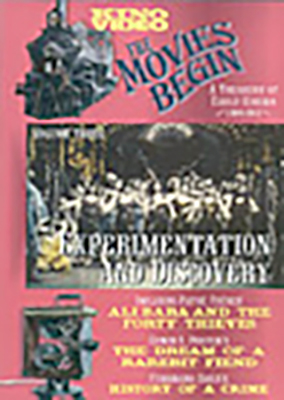 Volume Three: Experimentation and Discovery is comprised of British, French and American comedy, drama and documentary films held by the British Film Institute. Trick films with emphasis on special effects and new processes dominate this volume. The highlights of this volume are the droll Explosion of a Motor Car (1900), Ali Baba and the Forty Thieves (1902) in Pathé color tinting, Rescued by Rover (1905) which has a faint reflection of something unidentified across the entire image throughout the film (perhaps a reflection on work glass during the film’s rephotographing from a Library of Congress paper print), Aladdin; or, The Marvelous Lamp (1906), Dream of a Rarebit Fiend (1906) and That Fatal Sneeze (1907). This program was produced by Heather Stewart for the British Film Institute and has previously been available in the United Kingdom on videotape. Volume Three: Experimentation and Discovery is comprised of British, French and American comedy, drama and documentary films held by the British Film Institute. Trick films with emphasis on special effects and new processes dominate this volume. The highlights of this volume are the droll Explosion of a Motor Car (1900), Ali Baba and the Forty Thieves (1902) in Pathé color tinting, Rescued by Rover (1905) which has a faint reflection of something unidentified across the entire image throughout the film (perhaps a reflection on work glass during the film’s rephotographing from a Library of Congress paper print), Aladdin; or, The Marvelous Lamp (1906), Dream of a Rarebit Fiend (1906) and That Fatal Sneeze (1907). This program was produced by Heather Stewart for the British Film Institute and has previously been available in the United Kingdom on videotape.
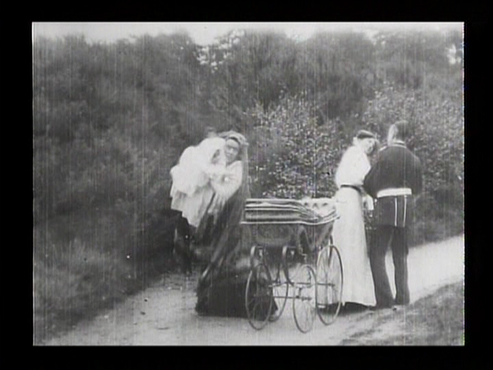
The complete volume contents are: Hepworth Film Manufacturing Company’s How It Feels to Be Run Over (1900), Explosion of a Motor Car (1900), Rescued by Rover (1905), The Other Side of the Hedge (1904) and That Fatal Sneeze (1907); Cricks and Martin’s A Visit to Peek Frean & Co.’s Biscuit Works (1906) extracts; Kineto Production Company’s A Day in the Life of a Coalminer (1910); Pathé Freres’ Par le trou de serrue [Peeping Tom] (1901), Histoire d’un Crime [History of a Crime] (1901), Ali Baba et les quarante voleurs [Ali Baba and the Forty Thieves] (1902) incomplete 1905 rerelease version, Reve et réalité [Dream and Reality] (1901), La Révolution en Russe [Revolution in Odessa] (1906), Aladin ou la Lampe Merveilleuse [Aladdin; or, The Marvelous Lamp] (1906), Le cheval emballé [The Runaway Horse] (1907), The Physician of the Castle [A Narrow Escape] (1908) incomplete, and [Magic Bricks] (1908); International Film Company’s Dewar’s Scotch Whiskey [Dewar’s — It’s Scotch] (1897); Edison Manufacturing Company’s The Gay Shoe Clerk (1903) and Dream of a Rarebit Fiend (1906).
The films are all windowboxed. Most of the films have been transferred from clear 35mm prints. The majority of the Hepworth films, one of the Edison films, and one of the Pathe films appear to be 35mm and 16mm prints copied from paper prints.
The films are presented with music accompaniment performed on piano by Neil Brand. Audio commentary by Barry Salt supplements the films.
Note: an error in the disc’s mastering results in the DVD player being stopped at the end of the film when How It Feels to Be Run Over is individually selected from either the Hepworth Films menu or the Text menu. The disc continues to run through the program if the viewer chooses to view all of the films.
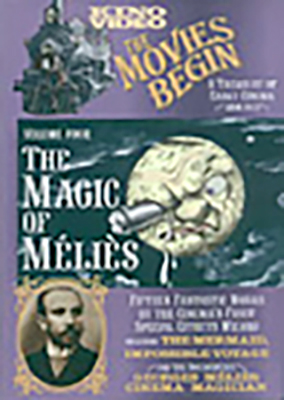 Volume Four: The Magic of Méliès is wholly devoted to the films of Georges Méliès. This program is currently offered on a separate DVD as Landmarks of Early Film, Volume Two: The Magic of Méliès published in 1999. The program was produced by David Shepard. Volume Four: The Magic of Méliès is wholly devoted to the films of Georges Méliès. This program is currently offered on a separate DVD as Landmarks of Early Film, Volume Two: The Magic of Méliès published in 1999. The program was produced by David Shepard.
Le Roi du maquillage [The Untamable Whiskers] (1904) utilizes a series of dissolves between shots of character makeup on Méliès. He draws the intended character on a blackboard then poses as the makeup appears on his face. Sorcellerie culinaire [The Cook in Trouble] (1904) is another example of a wizard and Méliès’ stop-action demons causing havoc in a cook’s kitchen. Le Thaumaturge Chinoise [Tchin-Chao, the Chinese Conjurer] (1904) features Méliès in Chinese garb and makeup performing stop-action magic. Le Merveilleux eventail vivant [The Wonderful Living Fan] (1904) is a costume piece with a man of royalty being entertained by a large fan that transforms into a fan of beautiful women. Le Sirène [The Mermaid] (1904) does more of Méliès’ trademark stop-action conjuring before the film turns to its real subject, a mermaid that turns into woman followed by Méliès transforming into Poseidon for the final tableaux.
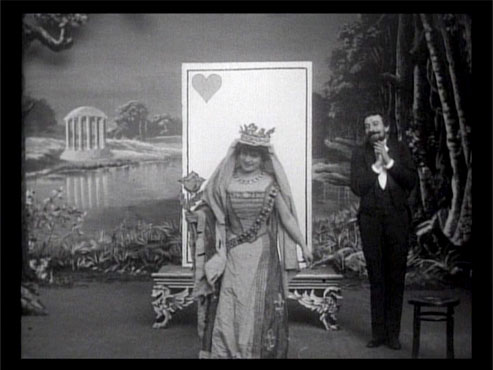
In Les Cartes vivantes [The Living Playing Cards] (1905) Méliès turns a playing to a live queen and back again, before making a king come alive and a surprise ending. Le Diable noir [The Black Imp] (1905) appears to use the same set as another Méliès film . . . another demon causes trouble for a hotel patron. La Chaise à porteurs enchantée [The Enchanted Sedan Chair] (1905) features an unusual combination of dissolve and cutting to create a transformation effect and some very smooth cutting effects. Le Tripot clandestin [The Scheming Gamblers Paradise] (1905) features a gambling parlor that transforms in a matter of seconds when the police are around. The police appropriate the hall for their own use. Les Affiches en goguette [The Hilarious Posters] (1905) features a transformation of paper posters into a series of living characters, but is also the kind of nonsense that 1905 audiences were beginning to get bored with.
L’Alchimiste parafaragamus ou la cornie infernale [The Mysterious Retort] (1906) a wizard, a snake, an imp, a spider, an apparition and a beautiful woman. What more could you want from a Méliès film? L’Eclipse du soleil en pleine lune [The Eclipse: The Courtship of the Sun and the Moon] (1907) harkens back to Méliès’ earlier fantastical excursions, and may feature the earliest use of intertitles in a Méliès film. Great expressions on the sun’s face. In La Colle universelle [Good Glue Sticks] (1907) two policemen break up the activities of a street merchant selling glue. When the policemen fall asleep on a park bench, the merchant gets his revenge by gluing the two policemen together. In La Photographie électrique à distance [Long Distance Wireless Photography] (1908) Méliès is a scientist who demonstrates his new invention.
The closing documentary, Georges Méliès: Cinema Magician, serves as an introduction to the cinematic work of Méliès. Its French-accented narration is a drawback, as is the generally moderate quality of the motion picture materials and soundtrack. Inserted into the documentary is a new transfer of a hand-tinted print of Le Voyage à travers l’impossible [An Impossible Voyage] (1904), which is a companion to the hand-tinted version of A Trip to the Moon (1902) available on disc one of this box set.
A bonus film, Another Job for the Undertaker (1901) is accessed through the ‘Text’ menu, between The Black Imp and The Enchanted Sedan Chair. Why an Edison film is placed within an all-Méliès program is beyond explanation. The short film could have been included somewhere on disc one with no problem.
Ignoring the older prints used in the Méliès documentary, the materials utilized for the video transfers of the short films range from very good to excellent. The print of The Cook in Trouble suffers from occasional frame jitters. Tchin-Chao, the Chinese Conjurer looks as though it was restored from a Library of Congress paper print, which is not a shortcoming. Many of the paper prints held by the Library of Congress have been recopied to 35mm restoration negatives and look almost indistinguishable from original filmstock prints. The Black Imp appears here in a much-improved print from the one utilized for the documentary. Overall, the program’s appeal is brought down by the documentary, but the generous number of quality Méliès’ films include here makes the disc worthwhile volume in this collection.
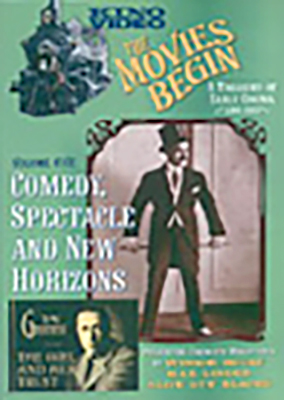 Volume Five: Comedy, Spectacle and New Horizons focuses on French and American comedy, the beginnings of Italian epic films and the maturing American short drama. While the films in this program are fewer, they are longer in duration than many of the other films in the set. From Pathé Frères is La Course des sergents de ville [The Policemen’s Little Run] (1907). It is a chase comedy of the run-of-the-mill sort that audiences must have been getting tired of after the initiation of the genre with Edison’s Tom, Tom, the Piper’s Son (1905). A group of comical policemen chase a dog that has stolen some meat. Audiences will sit up and take notice when the dog and police scale a building wall. The building exterior was painted onto the film studio floor and a camera mounted at the studio ceiling shooting downward tracks with the actors as they ‘climb’ the wall (on their hands and knees). The program was produced by David Shepard. Volume Five: Comedy, Spectacle and New Horizons focuses on French and American comedy, the beginnings of Italian epic films and the maturing American short drama. While the films in this program are fewer, they are longer in duration than many of the other films in the set. From Pathé Frères is La Course des sergents de ville [The Policemen’s Little Run] (1907). It is a chase comedy of the run-of-the-mill sort that audiences must have been getting tired of after the initiation of the genre with Edison’s Tom, Tom, the Piper’s Son (1905). A group of comical policemen chase a dog that has stolen some meat. Audiences will sit up and take notice when the dog and police scale a building wall. The building exterior was painted onto the film studio floor and a camera mounted at the studio ceiling shooting downward tracks with the actors as they ‘climb’ the wall (on their hands and knees). The program was produced by David Shepard.
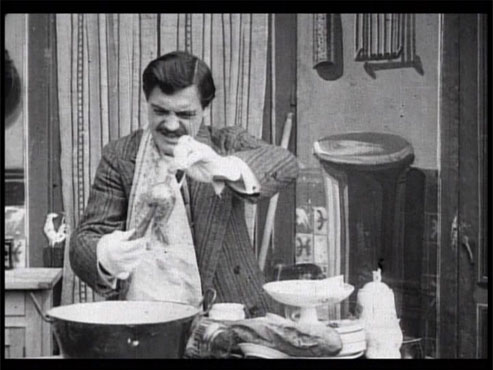
The most popular European comedian of his time, Frenchman Max Linder, is represented in his Pathé comedy Max reprend sa liberté [Troubles of a Grasswidower] (1912) misdated as 1908. It is easy to see why Linder was popular, as his charming performance here remains funny and inventive today.
Nerone [Nero; or, The Fall of Rome] (1909), produced by Ambrosia, represents Italian epic filmmaking in its advanced infancy. The story of Nero, Poppea and Octavia (with the burning of Rome happening offscreen) is told in one green and red tinted reel. Of note are the richly detailed sets and large number of extras. The film ends abruptly (probably due to film decomposition) with Nero’s decision to commit suicide.
Onésime horloger [Onésime, Clock-Maker] (1912) is a Gaumont production starring comedian Ernest Bourbon. Onésime inherits a fortune but cannot collect it for twenty years. To speed up the passage of time, he alters the pneumatic central clock to a time-speeding clock. The film contains a few fantastic Paris street views. The source print is a French original, with new English video intertitles made to resemble the Gaumont style.
Winsor McCay, the Famous Cartoonist of the N.Y. Herald and His Moving Comics (1911) features the master comic strip illustrator and John Bunny. McCay wagers he can make his comic strip characters move in one month’s time. The master’s first animated film.
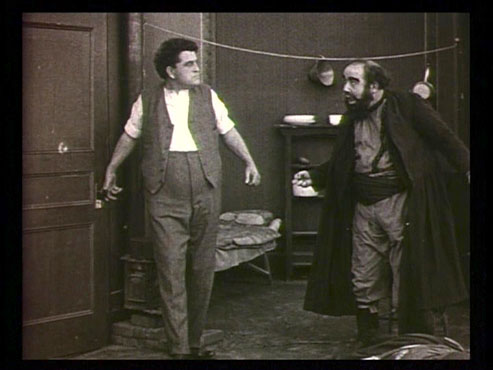
In the Solax film The Making of an American Citizen (1912), a Russian immigrant learns he must change his ways to live happily in America. The film was directed by pioneering French filmmaker Alice Guy Blaché. During disc mastering, at 8:44 into the film, the videotape master momentarily glitched causing a permanent video jiggle and audio warble that lasts a couple of seconds.
The disc is wrapped up by two representations of the next phase of film development, the maturation of storytelling technique. D.W. Griffith’s The Girl and Her Trust (1912) and Mack Sennett’s comedy Bangville Police (1913) are representative examples of cross-cutting editing techniques used to elevate and extend dramatic tension.
All of the films are transferred from 35mm prints and of exceptional quality. However, we are unhappy with the release years, director’s names, etc., that are superimposed on the original main titles of some of these films. If it truly is necessary to impart that information, simply create an introductory card that appears before the film begins. Note that some of the films are identified with incorrect release years.
Altogether, there are supposed to be 13 unannounced bonus films spread among the discs’ content, but we were only able to locate 11 of them. Considering the bonus films are quite short and are 16mm restoration prints of the Library of Congress paper prints, access to them is a small value-added perc.
For our comparative reviews of some of the individual films in this collection, see our Aladdin and the Marvelous Lamp on home video, Dream of a Rarebit Fiend on home video, The Great Train Robbery on home video, The Hilarious Posters on home video, The Making of an American Citizen on home video, The (?) Motorist on home video and A Trip to the Moon on home video pages.
If you do not already own David Shepard’s two-volume Landmarks of Early Film laserdisc or DVD editions culled from this collection, then seriously consider purchasing the Movies Begin boxset. All of the content of the Landmarks discs is available here, with the additional films of the other The Movies Begin programs and the bonus films of this early DVD edition.
|
This Region 0 NTSC DVD boxset has been discontinued
and is . . .
|

|
|
|
Other EARLY FILMS of the silent era available on home video.
Other MAX LINDER films available on home video.
Other GEORGES MÉLIÈS films available on home video.
Other BRITISH FILMS of the silent era available on home video.
Other FRENCH FILMS of the silent era available on home video.
Other KEYSTONE COMEDY FILMS available on home video.
Other SHORT COMEDY FILMS of the silent era available on home video.
Other ANIMATION FILMS of the silent era available on home video.
|
|
Comparison of Winsor McCay and His Moving Comics (1911) [also known as Little Nemo] from The Movies Begin and on the DVD Animation Legend: Winsor McCay.
|
|
|

LINKS IN THIS COLUMN
MAY TAKE YOU TO
EXTERNAL WEBSITES
•
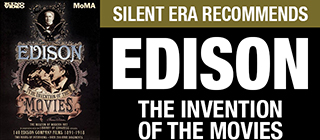
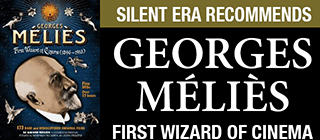
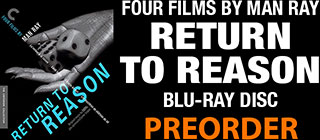
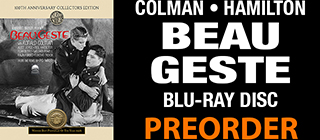


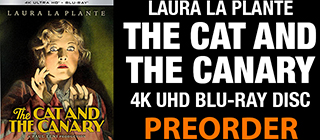


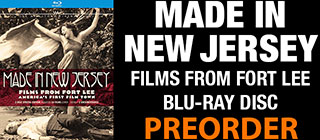

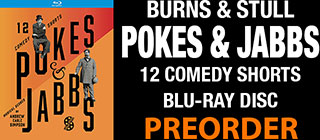


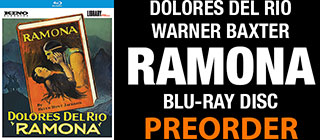
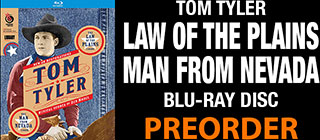
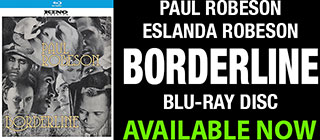
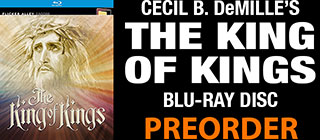
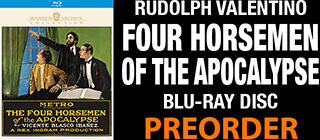
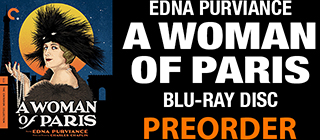
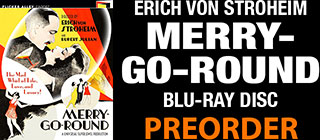

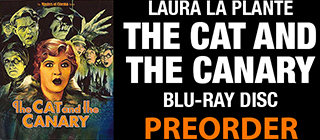


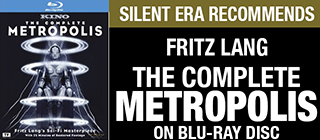
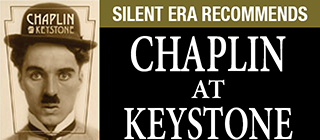




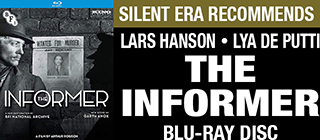


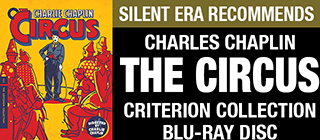
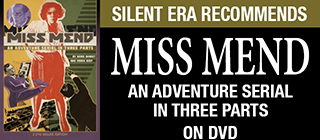
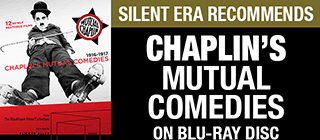
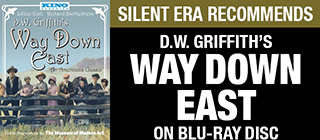


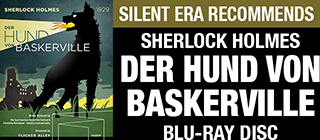
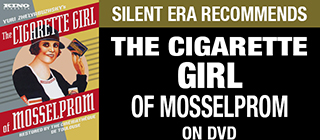
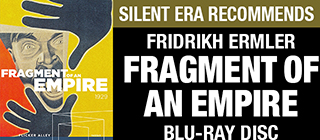

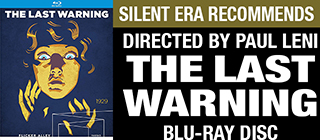
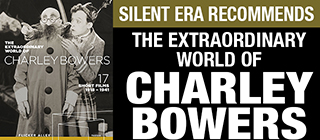
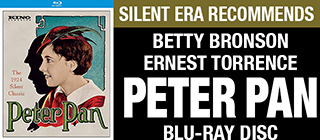
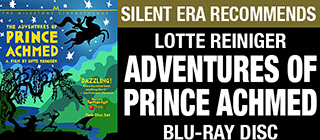
•
|




































